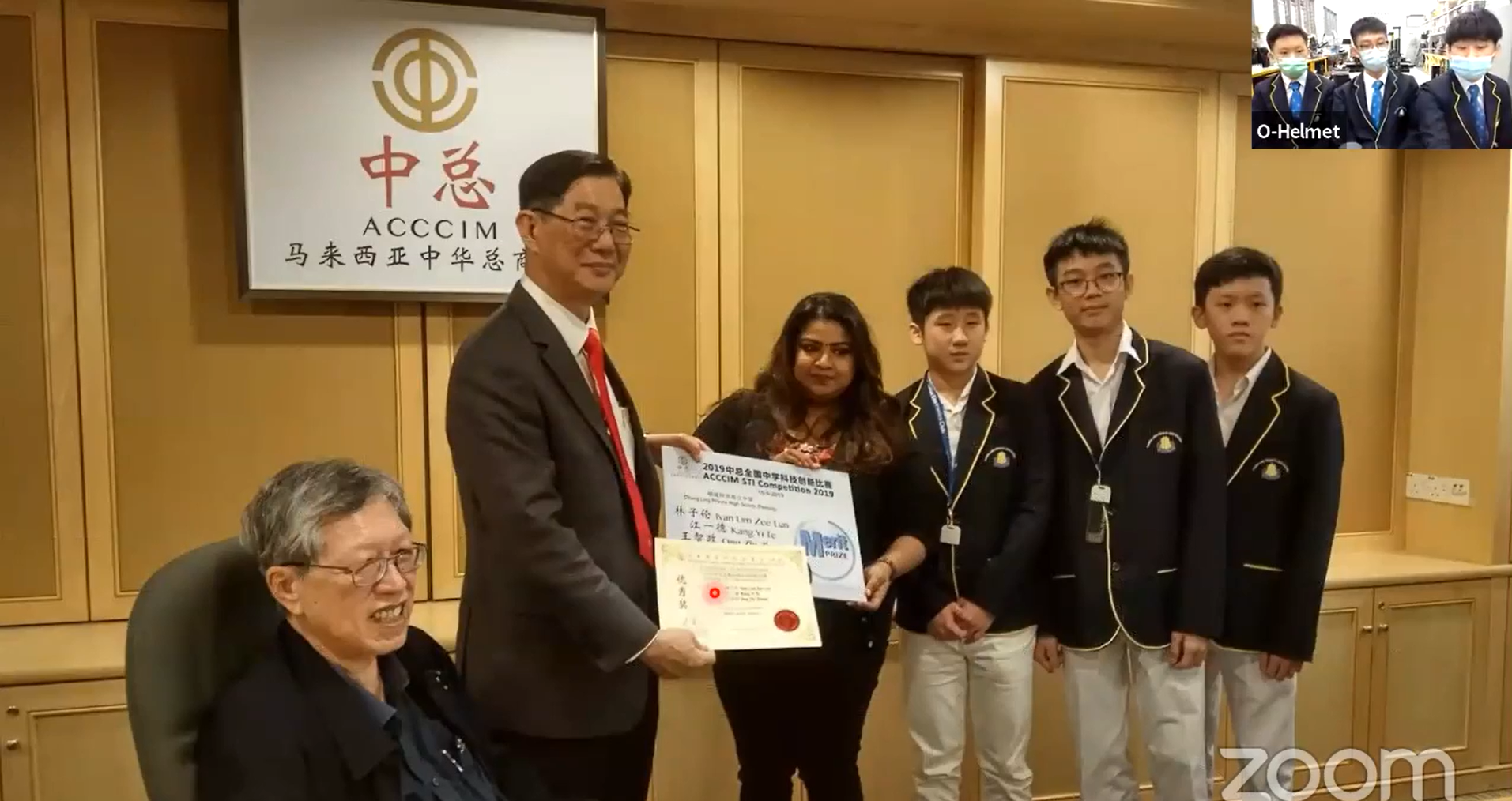
.jpg)
Poster of the webinar
In conjunction with Minggu Sains
Negara 2021 (MSN 2021), Kuala Lumpur Engineering Science Fair (KLESF) in
collaboration with UTAR, Ministry of Science, Technology and Innovation, and
Malaysian Industry-Government Group for High Technology (MIGHT) organised a
webinar titled "O-Helmet" on 7 April 2021 via Zoom and Facebook Live.

From left: Kang, Ong and Ivan Lim with moderator Lee
Invited to share at the webinar were
the Gold winners of KLESF International Challenge 2020 Ivan Lim Zee Lun,
Kang Yi Te and Ong Zhi Zheng, students from Chung Ling Private High School,
Penang. The webinar was moderated by KLESF Secretary Lee Woan Shiang.
Ivan Lim, Kang and Ong started the
webinar by sharing the idea behind the innovation of O-Helmet, “On 23 June
2018, a group of 12 boys aged between 11 and 16, from Thailand junior
football team, had an incident with their 25-year-old assistant coach when
they were trapped inside the Tham Luang Nang Non cave in Chiang Rai
Province, Thailand. Heavy rains partially flooded the cave and blocked their
way out. After being stranded on a narrow rock shelf in the dark for two
weeks, all of them were safely rescued.”
Ong said, “The obstructions in the
cave led to the breakdown of communication. Nobody knew the situation inside
the cave during the rescue as there was no signal available. Therefore, we
came up with an idea to create O-Helmet and repeaters. The O-Helmet is a
wearable communication system, designed to provide users in remote areas
wide range connectivity by implementing readily available mesh network
technology.”

The award-winning O-Helmet and repeaters
Ivan Lim explained the functions of
O-Helmet, “The helmet will send data every second through the series of
repeaters; it will send it back to the master controller - the operator of
the ground. On the other hand, the master controller can also send messages
through the series of repeaters and data will be received by the helmet. The
user with O-Helmet can read the message by using the smart glasses provided
and if they want to send a message to the master controller, they can press
the button beside the helmet.”

Kang showing the block diagram of the helmet
During the one-hour webinar, they
shared the functions of O-Helmet, future improvement for O-Helmet,
O-Helmet’s achievements, challenges and ways to overcome them, motivation
and many more.

Future improvement needed for O-Helmet
Speaking of future improvement, they
enthused, “We would like to add heartbeat sensor, cave pressure, infrared
thermometer and geolocation in the system. Other than that, we also want to
minimise the size of the repeaters for future convenience, and hope that in
the future we can control the helmet’s facilities by ourselves when we are
inside the cave.”



The three young innovators sharing some of their achievements
(photo was taken in 2019)
Kang highlighted, “The O-Helmet system
is not only designed to be used in caves; it can also be used in rain
forest, jungle or desert.”
Talking about the difficulties they
faced during the project, they said, “We took quite a long time to develop
the communication system, set up the mesh network technology and produce the
smart glasses. Other than that, it was also time-consuming when we first
generated our ideas as we did not know whether the ideas would work in the
end.”

(From left) the O-Helmet team roles by Ivan Lim, Kang and Ong
“Coming up with the project idea and
executing it was very hard initially, but with good teamwork, our challenges
became easier. I am glad that we have good chemistry and teamwork with one
another. Teamwork is very important because when there a problem occurs, all
of us will have to solve it together. We had our own roles and we followed
the scrambling technique in our execution. Scrambling technique is a digital
encoding technique that is used in modern data communication schemes and can
principally provide aid in retrieving information from received data
enhancing synchronisation between the transmitter and the receiver,” Ivan
Lim added.
Ivan Lim, Kang and Ong ended the
webinar by explaining how they balanced their time between studying and
doing the project. They advised, “As a student, studying is our main
responsibility; projects and activities are side dishes. When the exam is
around the corner, we will stop doing the project and other activities and
work hard on our studies. We will study for at least two weeks before the
exam. We will go back to our project once the exam finishes.”
They also recommended watching YouTube
channels such as “Paul McWhorter” and “Fireship.io” for further
self-learning on programming and coding.
The webinar ended with a lively Q&A
session.
For those who are interested to know
more, you may watch the full webinar
here.
![]()
![]()
Wholly owned by UTAR Education Foundation Co. No. 578227-M LEGAL STATEMENT TERM OF USAGE PRIVACY NOTICE